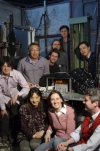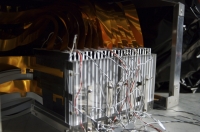 |
 |
|||||||||||||
|
|||||||||||||
|
|||||||||||||
When scientists take their detector prototypes to a test beam they enter a parallel world. Many basic needs are put on hold - the need for sunlight, regular meals or eight hours of sleep, for example. What counts is the beam time: you have three days, weeks or months to test your equipment, and you have to make the best of it because you might not get another chance. A team from Japan and Korea have just reached the halfway point of their time in the DESY test beam, calibrating, checking and recording data with their electromagnetic calorimeter prototype. The team from Asia brought three different components with them that they are testing consecutively in all possible configurations. To record and read out their data they use the readout system built in Europe for the hadronic calorimeter - proof of a working CALICE collaboration. “It's a very good beam, the electronics work very well, we're meeting old friends and we've got plenty of time - ideal conditions,” says Tohru Takeshita from Shinshu University. While the analysis of the results will only start properly when the team of ten scientists returns to their institutes in Japan and Korea, taking peeks at the screens in the control room they think it's looking pretty good so far. In the ILC detector they would like to build, the electromagnetic calorimeter, sandwiched between tracker and hadronic calorimeter, records all electrons and photons that pass through. It has to do this with amazing precision. Its big brother HCal is already more precise than any of its predecessors with a granularity of 3 by 3 centimetres, but the ECal needs a granularity of only 1 by 1 centimetre. They achieve this granularity by overlaying scintillator strips of 1 x 4.5 centimetres each cross-wise, separated from the next crossed layer by a sheet of tungsten. One goal of the test period at DESY is to find the best system. Current detectors, the tiny chips glued to the ends of the scintillators that are called silicon photomultipliers or SiPMs, aren't good at seeing blue light. However, photons passing through the scintillator will cause it to emit blue - or ultraviolet - light, so this has to be changed by a wavelength shifting fibre into a wavelength the detector can see. A new detector chip, the Multi-Pixel Photon Counter or MPPC developed by the Japanese company Hamamatsu Photonics, is able to see the blue light directly, making the system more robust and simpler to construct, but also making the signal weaker. "We want to test the advantages and disadvantages of the different systems," explains Kiyotomo Kawagoe from Kobe University. So the three different components - moulded scintillators with fibre, without fibre and a completely different system of extruded scintillators from Korea - of 26 layers in total are put in the beam in different combinations. First in line were system 1 in front of system 3, followed by system 1 in front of system 2 and so on. This will allow the scientists to directly compare the performance of the different systems. “The results from the Asian group's tests will be also extremely interesting for our group,” says Felix Sefkow from DESY who runs the HCal project in the CALICE collaboration. “Their conclusions concerning the photosensors will be relevant for our detector as well.” Erika Garutti, head of a research group that tests these sensors for the HCal, is also looking forward to seeing the results. “I am curious to see whether our tests match theirs.” -- Barbara Warmbein |
|||||||||||||
| © International Linear Collider |

